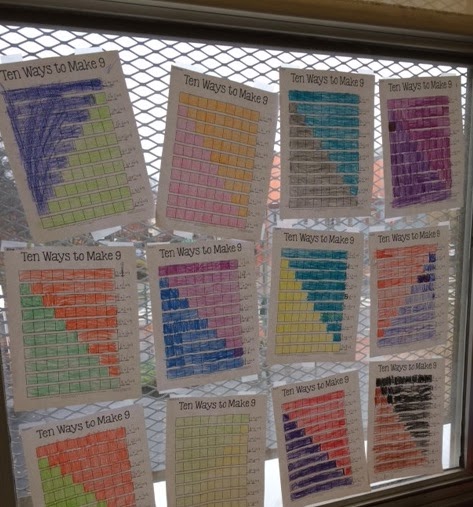Right before Winter Break we were in a Number System Unit in Math, focusing creating equivalent equations. I posed questions to the kiddos such as, "I have ten toys. Some of them are blocks. Some of them are marbles. How many of each could I have?" Our Investigations curriculum has a variety of these "how many of each?" problems throughout the first grade program.
This year my school is fortunate to have a consultant from the curriculum working with our staff, and she gave us some suggestions for how to make these lessons more meaningful and effective for our mathematicians. First, she encouraged us to have the kiddos build all of their equivalent expressions with connecting cubes.
 In the past I'd always used two-sided counters to help students visualize different combinations, but with the connecting cubes it's much easier to see how different combinations all equal the same number. As the kiddos constructed trains with two colors of cubes, it was also very evident how they were thinking about the problem. Some of them quickly organized their trains with the "pairs" next to each other (i.e. 2 red + 8 blue and 8 red + 2 blue); others started with 1+9 and increased one color while decreasing the other. Some of the kiddos just tried out various combinations to see if they added to 10.
In the past I'd always used two-sided counters to help students visualize different combinations, but with the connecting cubes it's much easier to see how different combinations all equal the same number. As the kiddos constructed trains with two colors of cubes, it was also very evident how they were thinking about the problem. Some of them quickly organized their trains with the "pairs" next to each other (i.e. 2 red + 8 blue and 8 red + 2 blue); others started with 1+9 and increased one color while decreasing the other. Some of the kiddos just tried out various combinations to see if they added to 10.  The second piece of advice we received was to keep the sums small. When the kiddos started guessing equivalent equations (8+5=10?), we were encouraged to scale back to a smaller number. Almost all of the kiddos could find equivalent expressions within 5, even when they struggled with 9 or 10. Even when a kiddos demonstrated understanding and fluency with combinations up to 10 or 12, we didn't provide a bigger sum. The reason being that once you realize the pattern (increase one color, or addend, while decreasing the other), you can do it with any number. Instead, we asked kiddos to try using three addends, or colors. This was a challenge, but most "high-flying" mathematicians love a puzzle and enjoyed giving it a try.
The second piece of advice we received was to keep the sums small. When the kiddos started guessing equivalent equations (8+5=10?), we were encouraged to scale back to a smaller number. Almost all of the kiddos could find equivalent expressions within 5, even when they struggled with 9 or 10. Even when a kiddos demonstrated understanding and fluency with combinations up to 10 or 12, we didn't provide a bigger sum. The reason being that once you realize the pattern (increase one color, or addend, while decreasing the other), you can do it with any number. Instead, we asked kiddos to try using three addends, or colors. This was a challenge, but most "high-flying" mathematicians love a puzzle and enjoyed giving it a try.
One of the first things I ever pinned on Pinterest was this "__ Ways to Make __" worksheet from Kinder-Craze. I decided it was perfect thing to add into this session to have one more way of visualizing equivalent combinations. We actually don't do much coloring in our class, so they loved getting to pull out the crayons and create these fun designs. (I don't have a lot of bulletin board space but they looked great on the window above our math shelf.


No comments:
Post a Comment